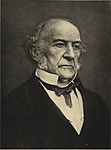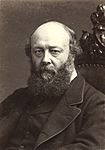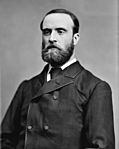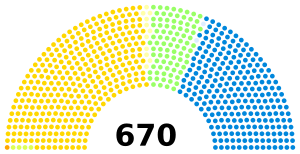1885 United Kingdom general election facts for kids
|
|||||||||||||||||||||||||||||||||||||||||||||
|
|
|||||||||||||||||||||||||||||||||||||||||||||
|
All 670 seats in the House of Commons 336 seats needed for a majority |
|||||||||||||||||||||||||||||||||||||||||||||
|---|---|---|---|---|---|---|---|---|---|---|---|---|---|---|---|---|---|---|---|---|---|---|---|---|---|---|---|---|---|---|---|---|---|---|---|---|---|---|---|---|---|---|---|---|---|
| Turnout | 81.2% | ||||||||||||||||||||||||||||||||||||||||||||
|
|||||||||||||||||||||||||||||||||||||||||||||
|
|
|||||||||||||||||||||||||||||||||||||||||||||
|
|||||||||||||||||||||||||||||||||||||||||||||
The 1885 United Kingdom general election was an important vote held in the UK. It took place from November 24 to December 18, 1885. This election was special because it was the first one after some big changes to who could vote and how voting areas were set up.
For the first time, most adult men in the UK were allowed to vote. Also, most voting areas (called constituencies) now elected only one Member of Parliament (MP). This was a big step towards making elections fairer. The Liberal Party, led by William Gladstone, won the most seats. However, they did not win enough seats to have a clear majority on their own.
This meant that the Irish Nationalists held the "balance of power." They could decide which of the two main parties (Liberals or Conservatives) would form the government. This situation caused problems for the Liberals, especially over the idea of Irish Home Rule. This was about giving Ireland more control over its own affairs. These disagreements eventually led to another election the very next year in 1886.
The 1885 election also marked the first time a socialist party took part. The Social Democratic Federation, led by H. M. Hyndman, had three candidates running for election.
Contents
Understanding the Election Results
This section explains how the different political parties performed in the 1885 election. It shows how many votes each party received and how many seats they won in Parliament.
How Many Votes Did Each Party Get?
This part looks at the total number of votes each party received across the country. It helps us see which parties were most popular with the voters.
| Popular Vote | ||||
|---|---|---|---|---|
| Liberal | 47.65% | |||
| Conservative | 43.00% | |||
| Irish Parliamentary | 6.88% | |||
| Independent Liberal | 1.28% | |||
| Crofters | 0.38% | |||
| Independent Conservative | 0.29% | |||
| Lib-Lab | 0.19% | |||
| Independent | 0.15% | |||
| Others | 0.18% | |||
- Liberal Party: They received the most votes, with 47.65% of all votes cast.
- Conservative Party: They were close behind, getting 43.00% of the votes.
- Irish Parliamentary Party: This party, focused on Irish issues, got 6.88% of the votes.
- Other Parties: Smaller parties and independent candidates made up the rest of the votes.
How Many Seats Did Each Party Win?
This section shows how many seats each party won in the House of Commons. Winning seats is what truly matters in an election, as it determines who forms the government.
| Parliamentary Seats | ||||
|---|---|---|---|---|
| Liberal | 47.61% | |||
| Conservative | 36.87% | |||
| Irish Parliamentary | 12.84% | |||
| Independent Liberal | 1.64% | |||
| Crofters | 0.60% | |||
| Independent Conservative | 0.30% | |||
| Lib-Lab | 0.15% | |||
- Liberal Party: They won 319 seats, which was the most. However, they needed 336 seats for a clear majority.
- Conservative Party: They won 247 seats.
- Irish Parliamentary Party: This party won 86 seats, a significant increase from the previous election. This gave them a lot of power.
- Other Parties: A few other parties and independent candidates won a small number of seats.
What Was the Voter Turnout?
Voter turnout tells us what percentage of people who could vote actually did vote. In this election, out of 5,708,030 eligible voters, 4,347,984 cast their ballots. This means the turnout was 81.2%. A high turnout shows that many people were interested in the election.
What Happened After the Election?
Since no single party won a clear majority, the election results led to a tricky situation. The Irish Parliamentary Party held the key to forming a government. This made the issue of Irish Home Rule even more important.
William Gladstone, the Liberal leader, became Prime Minister after the election. However, the disagreements over Irish Home Rule within his own party were very strong. This led to a split in the Liberal Party and another general election being called very soon after, in 1886.
More to Explore
- List of MPs elected in the 1885 United Kingdom general election
- Parliamentary franchise in the United Kingdom 1885–1918
- Representation of the People Act 1884
- Redistribution of Seats Act 1885
- Hawarden Kite, a story about Gladstone and Irish Home Rule







